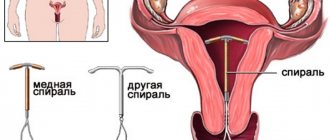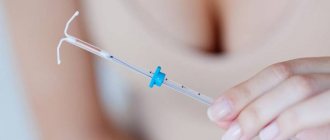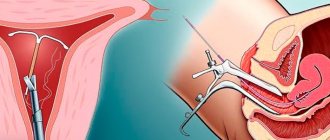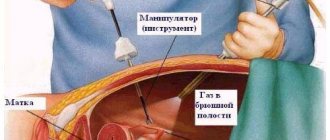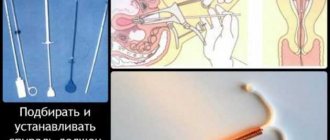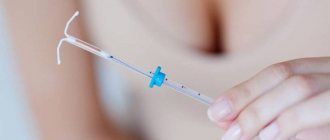Removal of the IUD (intrauterine device) is carried out if the contraceptive has expired or at the request of the patient (when planning pregnancy). Sometimes emergency removal of the IUD is required. This occurs with the development of complications provoked by the presence of a foreign body in the uterine cavity.
The procedure for removing the IUD is indicated if a woman is diagnosed with a pathological process in the reproductive organs, the development of amenorrhea. The likelihood of pregnancy when using this method of contraception is low, but this situation is possible. If a woman decides to give birth, it is recommended that the IUD be removed.
Tip 1: How to remove a spiral
The IUD is an effective method of contraception, but it is not suitable for everyone. An IUD cannot be inserted in the following cases:
— Presence of pregnancy — Bleeding from the genital tract of unknown origin — Pathology of the cervix — Submucosal (submucosal) myomatous nodes — Uterine fibroids for more than 5-6 weeks — Hyperplastic processes of the endometrium — Acute inflammatory diseases of the genital organs — Anomaly of the development of the genital organs (bicornuate uterus, saddle uterus , septum in the uterus) - Not recommended for nulliparous women
You can remove the IUD in St. Petersburg for your convenience at any of our medical centers. You can make an appointment by phone or through the registration form.
How is the spiral removed?
The gynecologist removes the intrauterine device by pulling on the “antennae” that hang freely from the cervical canal into the vagina. Before removing the IUD, it is advisable to visit a gynecologist to take a smear to determine the degree of cleanliness of the vagina. To remove an IUD, the day of the menstrual cycle is not important, that is, it can be removed on any day of the cycle, unlike insertion, which is done only during menstruation. This is done to make sure that the woman who wants to install the IUD is not pregnant. If the “antennae” are not visualized, the woman needs to undergo an ultrasound to make sure that the spiral is in the uterus. In this case, the spiral is removed using a medical instrument specially designed for this purpose.
Is it painful to remove the IUD?
Removal of the intrauterine device is usually not painful, but there may be some discomfort. If a woman has a low pain threshold, then local anesthesia with lidocaine spray is sufficient.
When and in what cases should the spiral be removed?
The coil must be removed after its expiration date. This is usually indicated on the packaging. The IUD can be removed at any time, at the woman’s request. Indications for removal are:
— Expulsion of the IUD — Hyperpolymenorrhea — Pregnancy — Intermenstrual bleeding — Acute inflammatory diseases of the genital organs — Hyperplastic processes of the endometrium — Pathological processes of the cervix
How long can I use the spiral?
The period for which a spiral can be installed can vary from 3 to 10 years. On average 5 years. The IUD cannot be used longer than the period indicated on the spiral packaging.
Is it possible to remove the spiral at home on your own?
Only a doctor should remove the IUD. There shouldn't be any other options. Trying to remove the coil yourself at home can lead to serious consequences.
What are the most famous brands of coils?
The most popular intrauterine devices among patients and gynecologists are Multiload, Juno, T Cu375, Nova T. The Mirena IUD with the therapeutic effect is increasingly recommended for women with adenomyosis, polymenorrhea, uterine fibroids, and endometrial hyperplastic processes.
...the entire encyclopedia
Removal of the intrauterine device: reasons
The following reasons are the most common for IUD removal:
- Displacement of the IUD inside the uterus. A woman can tell this by her mustache becoming shorter or longer. In this case, the old intrauterine device is removed and a new one is installed.
- The wearing period has expired. Most IUDs are designed to stay in the uterus for three to five years, although some types last up to 10. If the IUD is not removed during this period, inflammatory processes and endometrial growth may begin in the uterus.
- Pregnancy. Unfortunately, sometimes people get pregnant with an IUD. Extraction is carried out not only during normal pregnancy, but also in the case of ectopic pregnancy.
- The desire to have a child. A new pregnancy can occur almost immediately after the IUD is removed. Previously, doctors recommended that after this manipulation you should abstain a little from trying to conceive, but now this is only true when there are some complications (for example, inflammation of the endometrium due to the presence of the IUD).
- Growth of uterine tumor (fibroids) after installation of an IUD.
- Inflammation of the uterus and its appendages. In this case, removal of the intrauterine device may be accompanied by a course of antibiotics.
RECOVERY PERIOD
After removal of the IUD, no specific rehabilitation measures are required, but the woman should follow some recommendations. To prevent possible consequences within a week after the procedure, you must:
- refuse vaginal sexual intercourse;
- carry out thorough intimate hygiene;
- do not be exposed to physical activity, do not play sports;
- refuse to visit the pool, steam room;
- do not use hygienic vaginal tampons;
- do not douche.
Removal of the IUD may be accompanied by dull aching pain in the abdomen and scanty bleeding, which spontaneously disappears after a few days. If after this time the patient’s temperature rises, vaginal discharge becomes profuse and is accompanied by an unpleasant odor, and abdominal pain intensifies, then it is necessary to immediately consult a doctor.
Within 4-5 days after performing this manipulation, it is prohibited:
- use vaginal tampons
- have sex
- do douching
- take a bath, visit a bathhouse or sauna
- play sports, lift weights
- take medications containing acetylsalicylic acid
After the IUD is removed, the next menstruation may come on time or be delayed for several days. When using a hormonal IUD, periods can be restored after a longer period.
The intrauterine device is removed quite simply and quickly, but in no case should this manipulation be carried out independently. One awkward movement is enough and the contraceptive can injure the cervix, leading to erosion or bleeding. Incorrect removal can also result in parts of the IUD being torn off and retained in the cervix.
After removing the device, the woman should adhere to the following recommendations:
- abstain from sexual intercourse for 5-6 days;
- do not use tampons and vaginal suppositories;
- do not take hot baths, do not visit baths and saunas;
- limit physical activity.
Removing the IUD may affect your menstrual cycle. Your next period may be delayed. A woman sometimes feels discomfort in the lower abdomen and spotting appears.
Removing the intrauterine device: process
This procedure is absolutely painless if the woman is healthy. In any case, only a specialist should carry out the manipulation (if you extract it yourself, you can damage the mucous membranes of the uterus and its cervix).
This procedure is carried out in 2 stages:
- Preliminary examination of the woman. The gynecologist must assess the condition of the IUD and the possibility of its painless outpatient removal. If there are no tendrils of the IUD or some other obstacles arise, then the intrauterine device is removed using hysteroscopy.
- Direct removal of the IUD (usually during menstruation).
Preparing to remove the IUD
Before undergoing the procedure to remove an intrauterine contraceptive, the patient should consult a gynecologist. The doctor will conduct a thorough gynecological examination, assessing the position of the IUD, the length of the antennae and the type of intrauterine contraceptive. In addition, the doctor will perform an ultrasound examination of the pelvic organs, which will allow you to assess the nature and localization of possible pathological processes, and will also take a smear for microflora from the vaginal cavity and cervical canal.
Removing the IUD is the removal of the intrauterine device from the uterine cavity when its use has expired.
If the IUD is removed instrumentally, you must first perform a clinical and biochemical blood examination, as well as donate blood for hepatitis, HIV, RW. Depending on the medical indications, individual characteristics and health status of the patient, additional instrumental and laboratory examination methods (colposcopy, urine tests, bacteriological culture from the vagina) may be performed.
If there are active inflammatory processes, in addition to the standard diagnostic algorithm, the patient is prescribed antibacterial and anti-inflammatory therapy.
Consequences of non-intervention
A woman who is protecting herself from an unwanted pregnancy with an IUD must constantly monitor the condition of the genital organs, since there is a foreign body in the uterus, causing appropriate reactions from the body: the so-called aseptic inflammation of the inner surface of the uterus, etc. If you miss the deadline for removing the intrauterine device, it can grow into the endometrium so much that it will make the removal process in the usual way absolutely impossible.
MAKE AN APPOINTMENT
Home / Encyclopedia / What to do if you need to remove the spiral? Is it painful to remove an IUD?
The spiral, or intrauterine contraceptive device (IUD), is a device that is inserted into the uterine cavity for the purpose of contraception. The IUD is an effective method of contraception, but it is not suitable for everyone. An IUD cannot be inserted in the following cases:
— Presence of pregnancy — Bleeding from the genital tract of unknown origin — Pathology of the cervix — Submucosal (submucosal) myomatous nodes — Uterine fibroids for more than 5-6 weeks — Hyperplastic processes of the endometrium — Acute inflammatory diseases of the genital organs — Anomaly of the development of the genital organs (bicornuate uterus, saddle uterus , septum in the uterus) - Not recommended for nulliparous women
You can remove the IUD in St. Petersburg for your convenience at any of our medical centers. You can make an appointment by phone or through the registration form.
How is the spiral removed?
The gynecologist removes the intrauterine device by pulling on the “antennae” that hang freely from the cervical canal into the vagina. Before removing the IUD, it is advisable to visit a gynecologist to take a smear to determine the degree of cleanliness of the vagina.
Possible complications after IUD removal
In essence, the IUD is a foreign body to the body, sometimes causing various complications. After removing the IUD, a woman may develop the following consequences:
- Inflammation of the uterine appendages.
- Acute and chronic forms of endometritis.
- Bleeding.
After the IUD is removed, a woman may notice the following symptoms:
- Moderate bloody discharge.
- Pain in the pelvic area.
- Abdominal cramps.
The presence of aching pain reminiscent of menstrual pain is not considered a pathological situation and does not require consultation with a gynecologist. The appearance of discharge that has an unpleasant odor, an increase in temperature, and poor health are a direct reason to receive medical help.
How to remove a spiral at home video
To remove an IUD, the day of the menstrual cycle is not important, that is, it can be removed on any day of the cycle, unlike insertion, which is done only during menstruation. This is done to make sure that the woman who wants to install the IUD is not pregnant. If the “antennae” are not visualized, the woman needs to undergo an ultrasound to make sure that the spiral is in the uterus. In this case, the spiral is removed using a medical instrument specially designed for this purpose.
Is it painful to remove the IUD?
Removal of the intrauterine device is usually not painful, but there may be some discomfort. If a woman has a low pain threshold, then local anesthesia with lidocaine spray is sufficient.
When and in what cases should the spiral be removed?
The coil must be removed after its expiration date.
This is usually indicated on the packaging. The IUD can be removed at any time, at the woman’s request. Indications for removal are:
— Expulsion of the IUD — Hyperpolymenorrhea — Pregnancy — Intermenstrual bleeding — Acute inflammatory diseases of the genital organs — Hyperplastic processes of the endometrium — Pathological processes of the cervix
How long can I use the spiral?
The period for which a spiral can be installed can vary from 3 to 10 years. On average 5 years. The IUD cannot be used longer than the period indicated on the spiral packaging.
Is it possible to remove the spiral at home on your own?
Only a doctor should remove the IUD. There shouldn't be any other options. Trying to remove the coil yourself at home can lead to serious consequences.
What are the most famous brands of coils?
The most popular intrauterine devices among patients and gynecologists are Multiload, Juno, T Cu375, Nova T. The Mirena IUD with the therapeutic effect is increasingly recommended for women with adenomyosis, polymenorrhea, uterine fibroids, and endometrial hyperplastic processes.
...the entire encyclopedia
How to remove a spiral at home
By the way, the cost of the service in a residential complex starts from 600 rubles.
By the way, the cost of the service in a residential complex starts from 600 rubles.
Don't you need health? let me))
By the way, the cost of the service in a residential complex starts from 600 rubles.
It’s better not to take risks when it comes to pulling it out yourself. It may go well, but you may tear your neck or scratch it badly, then you will be tortured to treat
It’s better not to take risks when it comes to pulling it out yourself. It may go well, but you may tear your neck or scratch it badly, then you will be tortured to treat
Are you tired of living or do you want problems? What kind of thoughts? Or maybe we can establish it ourselves, without a doctor?
By the way, the cost of the service in a residential complex starts from 600 rubles.
Do you feel sorry for money? I rented for 300 rubles at the district consultation office
What nonsense? This service is free under compulsory medical insurance. However, just like the installation, you just need to bring your own spiral.
The doctor told me that the spiral is not included in the compulsory medical insurance, she paid both for insertion and removal and bought her own spiral
Working in the gynecology department, I observed women who had had the IUD in place for decades.:009: They had the uterine cavity curetted.
There is no need to take risks, the cervix is closed. And at least they can look at its location on the ultrasound :)
I didn’t realize: 009: that it could get stuck or tear the neck, especially bleeding.. oh! ..I thought everything would work out like clockwork)..
I'll take it off to the doctor when the wearing period ends!
but for your health, of course, it’s not a pity)
Without taking into account health issues, how can you physically remove the spiral yourself.
Are you too lazy to get to the railway station? Well, you can go to the edge for a fee at any commercial medical center, if you don’t have to sit in line for half an hour.
By the way, it’s free in the railway station - I recently installed
I’m sure that TS was just joking, out of nothing to do :)) because illiteracy in such matters is typical of young ladies in puberty, but certainly not of an adult woman with a child :))
Removing the intrauterine device: how it's done
Today, one of the most common means of contraception is the installation of an intrauterine device. This is a small copper plate that prevents the uterine cavity from closing. It is not recommended to wear it for more than 5 years.
The removal of the intrauterine device is performed by a gynecologist. This manipulation is carried out on the 5-7th day of the menstrual cycle. Before removing the contraceptive, the specialist widens the cervical canal. In most cases, the intrauterine device is pulled out by the antennae. If there are no antennae, the doctor uses a special tool - an extractor. It is a rod with a loop at the end. After removal from the device, a swab is taken from the cervical canal to make sure that an infection has not developed in the genitals.
When the spiral threads are lost, they resort to hysteroscopy. The examination allows you to clarify the location of the IUD and find out whether the contraceptive has adhered to the walls of the uterus.
If the intrauterine device has already grown to the walls of the uterus, removal is carried out using hysteroscopic forceps or an abortion forceps. If it turns out that the intrauterine device is located close to the vessels, bladder or ureter, the doctor may resort to laparotomy. If the contraceptive has penetrated into the free abdominal cavity, it is removed from the abdominal cavity using laparoscopic forceps.
Experts under no circumstances recommend that women remove the intrauterine device themselves. In this case, there is a very high probability of infection and complications.
Removing an intrauterine device is a responsible procedure, so make sure that your women's health is in the hands of an experienced doctor. This is a guarantee that everything will be fine.
Your gynecologist online
The spiral, or intrauterine contraceptive device (IUD), is a device that is inserted into the uterine cavity for the purpose of contraception. The IUD is an effective method of contraception, but it is not suitable for everyone. An IUD cannot be inserted in the following cases:
Bleeding from the genital tract of unknown origin
Pathology of the cervix
Submucosal (submucosal) myomatous nodes
Uterine fibroids for more than 5-6 weeks
Hyperplastic processes of the endometrium
Acute inflammatory diseases of the genital organs
Abnormal development of the genital organs (bicornuate uterus, saddle uterus, septum in the uterus)
Not recommended for nulliparous women
You can remove the IUD in St. Petersburg for your convenience at any of our medical centers. You can make an appointment by phone or through the registration form.
How is the spiral removed?
The gynecologist removes the intrauterine device by pulling on the “antennae” that hang freely from the cervical canal into the vagina. Before removing the IUD, it is advisable to visit a gynecologist to take a smear to determine the degree of cleanliness of the vagina. To remove an IUD, the day of the menstrual cycle is not important, that is, it can be removed on any day of the cycle, unlike insertion, which is done only during menstruation. This is done to make sure that the woman who wants to install the IUD is not pregnant. If the “antennae” are not visualized, the woman needs to undergo an ultrasound to make sure that the spiral is in the uterus. In this case, the spiral is removed using a medical instrument specially designed for this purpose.
Is it painful to remove the IUD?
Removal of the intrauterine device is usually not painful, but there may be some discomfort. If a woman has a low pain threshold, then local anesthesia with lidocaine spray is sufficient.
When and in what cases should the spiral be removed?
The coil must be removed after its expiration date. This is usually indicated on the packaging. The IUD can be removed at any time, at the woman’s request. Indications for removal are:
Acute inflammatory diseases of the genital organs
Hyperplastic processes of the endometrium
Pathological processes of the cervix
How long can I use the spiral?
The period for which a spiral can be installed can vary from 3 to 10 years.
Cost of services
| Name of service | price, rub. |
| Primary, outpatient appointment with an obstetrician-gynecologist (complaints, history taking, examination, drawing up an examination plan) | 2100 |
| Repeated appointment with an obstetrician-gynecologist, outpatient | 2100 |
| Consultation with an obstetrician-gynecologist, candidate of medical sciences | 2400 |
| Consultation with an obstetrician-gynecologist, head of department | 2600 |
| Consultation with an obstetrician-gynecologist, candidate of medical sciences, head of department | 2800 |
| Consultation with an obstetrician-gynecologist, doctor of medical sciences, professor | 3000 |
| Consultation with an obstetrician-gynecologist, chief physician of the clinic | 3300 |
| Removal of an intrauterine device (IUD) | 2000 |
| Removal of an intrauterine device (IUD) in the operating room | 9000 |
Dear patients! You can find a full list of services and price list at the reception or by phone. The administration tries to promptly update the price list posted on the website, but in order to avoid possible misunderstandings, we advise you to check the cost of services on the day of contact at the reception or call center by phone. The posted price list does not constitute an offer.
| Make an appointment | Make an appointment by phone or by filling out the online form |
The administrator will contact you to confirm your appointment. IMC "ON CLINIC" guarantees complete confidentiality of your request.
How to remove a spiral at home
On average 5 years. The IUD cannot be used longer than the period indicated on the spiral packaging.
Is it possible to remove the spiral at home on your own?
Only a doctor should remove the IUD. There shouldn't be any other options. Trying to remove the coil yourself at home can lead to serious consequences.
What are the most famous brands of coils?
The most popular intrauterine devices among patients and gynecologists are Multiload, Juno, T Cu375, Nova T. The Mirena IUD with the therapeutic effect is increasingly recommended for women with adenomyosis, polymenorrhea, uterine fibroids, and endometrial hyperplastic processes.
All rights to pictures and texts belong to their authors.
The materials are presented for informational purposes only. The proposed treatment methods and medications have contraindications, consult a specialist!
Home / Encyclopedia / What to do if you need to remove the spiral? Is it painful to remove an IUD?
The spiral, or intrauterine contraceptive device (IUD), is a device that is inserted into the uterine cavity for the purpose of contraception. The IUD is an effective method of contraception, but it is not suitable for everyone. An IUD cannot be inserted in the following cases:
— Presence of pregnancy — Bleeding from the genital tract of unknown origin — Pathology of the cervix — Submucosal (submucosal) myomatous nodes — Uterine fibroids for more than 5-6 weeks — Hyperplastic processes of the endometrium — Acute inflammatory diseases of the genital organs — Anomaly of the development of the genital organs (bicornuate uterus, saddle uterus , septum in the uterus) - Not recommended for nulliparous women
You can remove the IUD in St. Petersburg for your convenience at any of our medical centers. You can make an appointment by phone or through the registration form.
How is the spiral removed?
The gynecologist removes the intrauterine device by pulling on the “antennae” that hang freely from the cervical canal into the vagina. Before removing the IUD, it is advisable to visit a gynecologist to take a smear to determine the degree of cleanliness of the vagina. To remove an IUD, the day of the menstrual cycle is not important, that is, it can be removed on any day of the cycle, unlike insertion, which is done only during menstruation. This is done to make sure that the woman who wants to install the IUD is not pregnant. If the “antennae” are not visualized, the woman needs to undergo an ultrasound to make sure that the spiral is in the uterus. In this case, the spiral is removed using a medical instrument specially designed for this purpose.
Is it painful to remove the IUD?
Removal of the intrauterine device is usually not painful, but there may be some discomfort. If a woman has a low pain threshold, then local anesthesia with lidocaine spray is sufficient.
When and in what cases should the spiral be removed?
The coil must be removed after its expiration date. This is usually indicated on the packaging. The IUD can be removed at any time, at the woman’s request. Indications for removal are:
— Expulsion of the IUD — Hyperpolymenorrhea — Pregnancy — Intermenstrual bleeding — Acute inflammatory diseases of the genital organs — Hyperplastic processes of the endometrium — Pathological processes of the cervix
How long can I use the spiral?
The period for which a spiral can be installed can vary from 3 to 10 years.
Advantages of ON CLINIC
The Center for Obstetrics and Gynecology ON CLINIC provides services for the introduction and removal of intrauterine contraceptives. Our doctors have extensive experience in performing such procedures. Highly qualified specialists allow the procedure to be performed quickly, painlessly with minimal discomfort for the patient.
https://www.youtube.com/watch?v=kV5CI8T9m3E
We use only safe drugs for anesthesia. They are quickly eliminated from the body without causing harm to it.
Is it painful to remove an intrauterine device?
On average 5 years. The IUD cannot be used longer than the period indicated on the spiral packaging.
Is it possible to remove the spiral at home on your own?
Only a doctor should remove the IUD. There shouldn't be any other options. Trying to remove the coil yourself at home can lead to serious consequences.
What are the most famous brands of coils?
The most popular intrauterine devices among patients and gynecologists are Multiload, Juno, T Cu375, Nova T. The Mirena IUD with the therapeutic effect is increasingly recommended for women with adenomyosis, polymenorrhea, uterine fibroids, and endometrial hyperplastic processes.
...the entire encyclopedia
Popular questions:
During a course of antibiotics, conception occurred. How dangerous is this for the fetus? I want to reschedule my period because I’m going on vacation. Can this be done, and if so, how? I was diagnosed with uterine fibroids 5-6 weeks ago. I wanted to get an IUD, but my doctor forbade me. Is she right?
Home / Encyclopedia / What to do if you need to remove the spiral? Is it painful to remove an IUD?
The spiral, or intrauterine contraceptive device (IUD), is a device that is inserted into the uterine cavity for the purpose of contraception. The IUD is an effective method of contraception, but it is not suitable for everyone. An IUD cannot be inserted in the following cases:
— Presence of pregnancy — Bleeding from the genital tract of unknown origin — Pathology of the cervix — Submucosal (submucosal) myomatous nodes — Uterine fibroids for more than 5-6 weeks — Hyperplastic processes of the endometrium — Acute inflammatory diseases of the genital organs — Anomaly of the development of the genital organs (bicornuate uterus, saddle uterus , septum in the uterus) - Not recommended for nulliparous women
You can remove the IUD in St. Petersburg for your convenience at any of our medical centers. You can make an appointment by phone or through the registration form.
How is the spiral removed?
The gynecologist removes the intrauterine device by pulling on the “antennae” that hang freely from the cervical canal into the vagina. Before removing the IUD, it is advisable to visit a gynecologist to take a smear to determine the degree of cleanliness of the vagina. To remove an IUD, the day of the menstrual cycle is not important, that is, it can be removed on any day of the cycle, unlike insertion, which is done only during menstruation. This is done to make sure that the woman who wants to install the IUD is not pregnant. If the “antennae” are not visualized, the woman needs to undergo an ultrasound to make sure that the spiral is in the uterus. In this case, the spiral is removed using a medical instrument specially designed for this purpose.
Is it painful to remove the IUD?
Removal of the intrauterine device is usually not painful, but there may be some discomfort. If a woman has a low pain threshold, then local anesthesia with lidocaine spray is sufficient.
When and in what cases should the spiral be removed?
The coil must be removed after its expiration date. This is usually indicated on the packaging.
Diagnostics
The diagnosis can be made after a hysteroscopy has been performed. After this procedure, specialists determine the condition of the spiral and determine the severity of the problem.
The intervention of microsurgery will allow you to choose the right tactics for eliminating the IUD and performing the operation as a whole. The risk is borne by the operation that is associated with touching internal organs. If the coil grows into the vessels, this can lead to major bleeding during the operation.
Contraindications:
- Infectious diseases and inflammatory processes;
- Bleeding due to problems with the uterus;
- Uterine cancer;
- Liver or kidney failure;
- Cervical stenosis;
- Vascular diseases;
- Heart problems.
Popular articles
- When can you do an ultrasound to determine pregnancy?
- How much does an ultrasound cost in Astana?
- Treatment of complications of STIs
- Treatment of complications of STIs in women
A specialist can diagnose an ingrown helix after performing a hysteroscopy. The study helps determine the condition of the contraceptive and the degree of its growth into the walls of the uterus. Microsurgical intervention allows you to choose the tactics for removing the IUD and determine its location. If the spiral is located near other internal organs and large vessels, surgical intervention will be risky. The patient is warned about all possible risks before the procedure.
Contraindications to hysteroscopy include: inflammatory and infectious diseases of the genitourinary system, uterine bleeding, pregnancy, cervical cancer or stenosis, vascular and heart diseases, renal and liver failure.
How to remove the IUD from the uterus
The IUD can be removed at any time, at the woman’s request. Indications for removal are:
— Expulsion of the IUD — Hyperpolymenorrhea — Pregnancy — Intermenstrual bleeding — Acute inflammatory diseases of the genital organs — Hyperplastic processes of the endometrium — Pathological processes of the cervix
How long can I use the spiral?
The period for which a spiral can be installed can vary from 3 to 10 years. On average 5 years. The IUD cannot be used longer than the period indicated on the spiral packaging.
Is it possible to remove the spiral at home on your own?
Only a doctor should remove the IUD. There shouldn't be any other options. Trying to remove the coil yourself at home can lead to serious consequences.
What are the most famous brands of coils?
The most popular intrauterine devices among patients and gynecologists are Multiload, Juno, T Cu375, Nova T. The Mirena IUD with the therapeutic effect is increasingly recommended for women with adenomyosis, polymenorrhea, uterine fibroids, and endometrial hyperplastic processes.
...the entire encyclopedia
